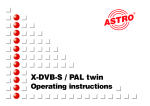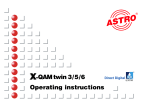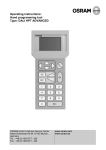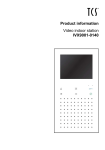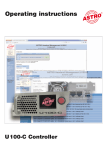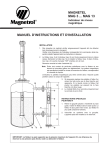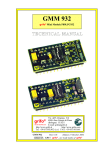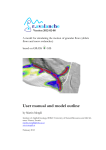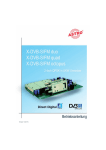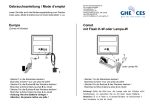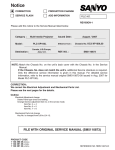Download BA DVB-T PAL twin
Transcript
X-DVB-T / PAL twin Operating Instructions Illustration Contents Contents Pictographs 1 Description . . . . . . . . . . . . . . . . . . . . . . . . . . . . . . . . Page 3 2 Installation of X-DVB-T / PAL twin card . . . . . . . . . Page 4 2.1 Cabling of X-DVB-T/PAL twin . . . . . . . . . . . . . . Page 4 3 Programming with the HE-Programming software Page 4 4 Basics for programming with the KC 3 . . . . . . . . . . Page 9 4.1 Structure . . . . . . . . . . . . . . . . . . . . . . . . . . . . . . Page 9 4.2 Order of Programming . . . . . . . . . . . . . . . . . . . Page 9 4.3 Store . . . . . . . . . . . . . . . . . . . . . . . . . . . . . . . . Page10 5 Programming with KC 3 . . . . . . . . . . . . . . . . . . . . . . Page10 5.1 Parameters of the base unit / slot . . . . . . . . . . . . . . . . . . . . . . . . . Page10 5.1.1 Setting the bus address . . . . . . . . . . . . . Page10 5.1.2 Setting the slot . . . . . . . . . . . . . . . . . . . . Page10 5.2 Setting the RF-output parameters . . . . . . . . . . Page10 5.2.1 Setting RF-output frequency . . . . . . . . . . Page10 5.2.2 Switching off the output signal . . . . . . . . Page10 5.3 Setting the input parameters . . . . . . . . . . . . . . Page11 5.4 Editing the input parameters . . . . . . . . . . . . . . . Page12 5.4.1 Choosing a program . . . . . . . . . . . . . . . . Page12 5.4.2 Audio options . . . . . . . . . . . . . . . . . . . . . Page12 5.4.3 Manual program choise . . . . . . . . . . . . . Page12 5.4.4 Video options / test signals . . . . . . . . . . . Page13 6 Short overview of programming steps . . . . . . . . Page14 7 Technical Data . . . . . . . . . . . . . . . . . . . . . . . . . . . . . . Page15 X-DVB-T / PAL twin plug-in card 2 . . . . . . . . . . . . . . . . . . . . . . . . . . . . . . . . Page 3 Pictograms 1 Description 1 Pictograms and safety information The X-DVB-T / PAL twin card is designed for the transcoding of two digital terrestrial TV-programmes into standard PAL-signals within the frequency range 47 – 862 MHz. It contains two independent input demodulators and one shared output converter. This means any two terrestrial programmes can be converted in two adjacent channels. Data Services as VPS or Teletext can be switched on and off as well as the generation of test signals. Each board has a level control for level matching of the individual plug-in boards to the same output level via KC 3 or HE-programming software. Pictograms are symbols which have a defined meaning. You will encounter the following pictograms in these operating and installation instructions: This symbol is used to warn about situations in which there is a risk of fatal injury due to dangerous electrical voltages or as a result of failure to comply with these instructions. This symbol is used to warn about various risks to health, equipment/materials or the environment. ☞ Description This symbol is used to indicate general information. Recycling symbol: all of our packaging materials (cardboard packaging, package inserts, plastic film and plastic bags) can be fully recycled. Please note: Authorized and qualified personnel only, is allowed to change the plug-in modules. Before this, the operating instructions, and especially the security advises, of the V16 base unit have to be read and followed. All works have to be done according to the security standards DIN VDE 0701, part 1 and 200. Electronic equipment is not household waste – in accordance with directive 2002/96/EC OF THE EUROPEAN PARLIAMENT AND THE COUNCIL of 27th January 2003 on used electrical and electronic equipment, it must be disposed of properly. At the end of its service life, take this unit for disposal at a relevant official collection point. 3 1 Description 2 2 Pre-configuration Installation of X-DVB-T / PAL twin card The X-DVB-T/PAL twin module can be operated in the input X-2 twin, X-5 twin, X-8 twin and V16 base unit. After mounting the module, please re-check the correct fitting of the sockets. 2.1 Cabling of X-DVB-T/PAL twin The X-DVB-T/PAL twin can be operated with a bridge for the input signal. This means that the signal from the loop-through output of Tuner A is bridged to the input of Tuner B. Tuner A and tuner B connected separately with input signal 3 Programming with the HEProgramming Software After the installing, the X-DVB-T / PAL twin card can be programmed via HE-Programming software. If it is not possible to choose the X-DVB-T / PAL twin card from the list in the „Overview of the base unit“, you should check the settings at “Options” → “Favoured plug-in cards. The card must be activated as below, to appear on the list in the „Overview of the base unit“. Input signal bridged from tuner A to tuner B 4 2 Pre-configuration 2 Pre-configuration In the overview of the base-unit, you can set the output channels of the X-DVB-T / PAL twin card at “RFParameters”. This means those channels, in which the, from the DVB-T bouquet selected, programs are inserted to the cable network. The chosen channel is always channel A. Channel B is automatically determined as adjacent channel of channel A. After reading out the base unit, the X-DVB-T / PAL twin card appears in the “Overview of the base unit“ on the used slot. ☞ Please Note:: Required Software version: X-5 Basis twin: 4.00 X-8 Basis twin: 1.21 V16: 1.21 Programming software 4.90 If you now click on the “Details” button, a window opens for configuring the card details. Here you can make the relevant settings for the operation. At the area „Input parameters“ you can set the input channel, the bandwidth, the mode and the guard interval. 5 3 Programming with the HE programming software 3 Programming with the HE programming software If you use the button “Check signal quality”, the C/N and the Bit error ratio of the input signal of the card will be displayed. You can choose the program from the transponder after a channel search, you are asked to do after programming the X-DVB-T / PAL twin card. At the area “HF-Output parameter”, the output channel can be activated and deactivated. In addition you can increase or decrease the Audio amplitude, change the Audio-Mode (Mono, Stereo…), and the TV standard (PAL or SECAM). 6 3 Programming with the HE programming software 3 Programming with the HE programming software Following to the channel search, the list with the included programs chooseable from the transponder opens up automatically. If you choose a multilingual transmitted program, you have the possibily to select different audio-PIDs. The program is chosen by clicking on it, without programming the card again. 7 3 Programming with the HE programming software 3 Programming with the HE programming software But on the television screen you can see the error message for example „NO INPUT DATA“. This is why the manual program search must be tested in the output of the head end with TV-Set or measurement equipment. If you click on “Options” in the window of the “Parameters of the Plug-in card”, the following window appears: Changes are only written and stored into the Plug-in card after clicking the button “Write Options“. The level adjustment of the X-DVB-S/PAL twin card can also be done via HE-programming software. For this you just have to click on “Level control“ in the window “Parameters of the Plug-in card”. With “Read Options”, the parameters programmed into the card will be read out and displayed. These parameters are Data Services, Test lines or manual program selection. Here you can (de-) activate data services as VPS or Teletext if provided by the transmitter and fix the CNI code hexa-decimal. Further on, there is the possibility to switch on or off test lines, and to type in the line in which the test line should be keyed in. The valid range for keying in test lines is between 17–28 and 330 and 341. ☞ Please note, that the testing lines are priorised, if the same line is choosen for teletext and testing lines! If you activate the manual program selection, and you type in invalid PIDs, there is no error message in the HE-programming software! 8 3 Programming with the HE programming software 4 Fundamentals for programming with the KC 3 By pressing the cursor keys ← or → you get into the menu for adjusting the parameters of the base unit, and then to the First of all you should push the button „Parameter read“, to read out the already programmed state of attenuation. The next step is the correction of the attenuation in 0,5 dB – steps. To store the changed values press „Parameter write“. Programming of the specific parameters of the card which consists of 4 lines. You can switch between these lines with the ↑ and ↓ keys. If you push the button „Restart cards“ in the window „Details of the Plug-in card“, all Plug-in cards of the base-unit will be restarted. This leads to a short-term loss of vision. This is why you have to confirm the restart. Line 1: type of card, here X-DVB-T/PAL twin A/B Status OK Line 2: Choosing the input and (de-) activating the ON-Screen-display Line 3/4: RF – output parameters The programming of the parameters is made via keypad or as stepwise change of pre-defined parameters with the cursor ↑ or ↓. 4 4.1 Basics for the programming with the KC 3 ☞ Please note: Input values must be complete! 4.2 Order of programming 1. Choose the Plug-in card (line 1) 2. Type in the output parameters of the Plug-in card (line 3/4) 3. Adjust the connected TV-measurement device on the programmed output frequency 4. Turn on the on-screen-display (line 2) 5. Type in the input parameters in the on-screen-display 6. Switch off the on-screen-display (line 2) Structure After plugging the KC 3 handheld on the base unit, the start menu appears. The software version is displayed. Please give this number to our customer service if you have questions regarding the X-DVB-T/PAL twin card. To see this menu later once again, you have to plug the KC 3 out and in again. 9 4 Fundamentals for programming with the KC 3 4.3 5 Programming with the KC 3 Store 5.2.1 The RF-output frequency can be adjusted in line three with the input of the frequency value by keypad or in line four with the stepwise change by cursor keys ← or → (100-kHz-steps). After finishing the data input, the new parameters have to be stored by pushing the “OK/Store” button. After pushing this button, the parameters are saved. 5 Programming with the KC 3 ☞ After choosing the slot (chapter 4), the programming of the Plug-in card can begin. 5.1 Choosing parameters of the base unit / slot 5.1.1 Adjusting the bus address of the base unit • • • 5.2 The input will not be checked, this means that a wrong input is stored after pushing the “OK/Store” button without warning! Select line 3 with the cursor keys ↑ or ↓ Adjust the bus address with the cursor keys ← or → in a range between 001 – 020, 241 Store changed addresses with „OK / Store“ 5.2.2 Choosing the slot • • Please note: The adjusting of the output frequency should always be done by choosing the channel in line 4. This makes sure that the picture carrier has a frequency according to the corresponding channel grid. Therefore the frequency in line 3 is changed automatically with the changed output channel. The output channel can be changed with the cursor keys ← or →. If you connect several base units with the ASTRO bus system, you have to make sure, that the connected base units are adjusted on different bus addresses (delivery state 241). 5.1.2 Adjusting RF- output frequency Switching off the output signal By pushing the „Menü / Read“ – button in the third line, you get to the option “Output signal On/Off”. The output signal is switched on or off with the cursor keys ← or →. Select line 1 with the cursor keys ↑ or ↓ Choose the required slot with the cursor keys ← or → Adjusting the RF-output parameters By pushing the cursor keys ↑ or ↓ you get into the third or fourth line. Here you can insert the required RF-output parameters. To activate the changes push the „OK / Store“ button. 10 5 Programming with the KC 3 5.2.3 5 Programming with the KC 3 Error messages By pushing the „Menü / Read“ – button in the third line, you get to the display of error messages. The operational state of the plug-in card is displayed. The error message 00000010 for example stands for a missing input signal. If any other error message appears, please contact our customer service. 5.2.4 To start the configuration, select the Menu „Channel Settings“ Level adjustment of X-DVB-T/PAL twin by choosing the menu „Channel Settings“ with the „OK / Store“ – button. Then you get to the main parameters of the plug-in card. By pushing the „Menü / Read“ – button in the third line, you get to the level adjustment of the X-DVB-T/PAL twin plug-in card. The level can be adjusted via cursor keys ← or → in a range from 0 dB up to 15,5 dB (0,5 dB – steps). All changes must be stored by pushing the “OK / Store” button. ☞ Important note: You should never compensate outgoing cable attenuation by different level adjustment of the plug-in card! To do this, use the output coupler U-901 (order no.: 380 190) or VZN 8 (order no.: 380 191). 5.3 Configuration of input parameters To configure the input parameters, you have to activate the on-screen-menu first. By pushing the “Menü / Read” – button in line 2, the following picture appears on the TV set or measurement device. The movement between the different lines can be done with the ↑ or ↓ – keys. The parameters can be changed with the ← or → keys, or the input with the numerical keypad in the “Frequency” option. 11 5 Programming with the KC 3 ☞ 5 Programming with the KC 3 Please note: Parameters, which are pre-defined on “auto”, should only be changed by experts. 5.4.2 Audio – Options If you now choose a program of the chosen bouquet, the following menu appears: Setting the input parameters: • Type in the input frequency with the numerical keypad or choose the input channel with cursor keys • Adjusting the bandwidth • Type in the FFT mode • Choose the guard interval • Tune again 5.4 Configuration of output parameters 5.4.1 Choosing a program To change details of the output parameters, you have to choose “Select Service” in the menu “Main Parameter”. Therefore you have to choose the “Select Service” button with the cursor keys ↑ or ↓. Confirm your choice with the “OK / Store – key. The following picture appears (example): Here you have the possibility to change the audio language, the volume, the audio mode and the configuration of the subtitle. Any changes have to be confirmed by pressing the “OK / Store” – button. by pressing the “Change Service” button you get back to the service selection. 5.4.3 Manual Program Choice If the requested station / program does not appear in the list “Select Service” you have to choose the last point “Manual PID”. Here you can choose a program manually: 12 5 Programming with the KC 3 5 Programming with the KC 3 Please choose „Options“ in the start menu. The now opened window offers the following configuration possibilities: In this sub-menu, the video PID, audio PID and Teletext PID have to be entered four-digit decimal. The hexadecimal PID will be converted by the card software and displayed next to the decimal PID. If you choose a program like this and you type in wrong PIDs, there will be no error message on the OSD! This error message will be displayed in the TV-Set, for example „NO INPUT DATA“. These error messages can be faded out. For doing this, please read chapter 5.4.4. 5.4.4 Activating or deactivating of Teletext (if transmitted), VPS (if transmitted) and OSD error messages as well as choosing the video standard (PAL or SECAM). Furthermore you can activate a fixed CNI. If you now choose the submenu „Test signales“ you you have the pssibility to activate different test signals. There are two different test signals to choose: 1. black picture (choose „Black“) or 2. vertical colored beams (choose „BAR 75“) Video – Options / Test signals By choosing „OFF“, you see the normal program in the TV set after deactivating the OSD. The X-DVB-T/PAL twin – card offers the possibility to key in test lines. For the configuration of those test lines please choose “Test Lines” in the submenu “Options”. 13 5 Programming with the KC 3 6 Short-overviev of programming steps Startmenü (appears only once after plugging in the KC3): ASTRO V16 Version 2,01 1 = deutsch (next < >) V16 Setup VMS 616 yes Power A+B Password off “ Menu / Read” → V16 Serie Password 0000 Password OK Menu New PW xxxx Choose Line 4 Password on → then “OK/Store” with Cursorbuttons ← or → to Menu 1 Menu 1 — Choosing the slot / channel: Several different test lines can be activated and deactivated. If you activate a test line you can choose the line for keying it in. The valid range for keying in the test line is between 17 – 28 and 330 – 341. Any changes have to be stored by choosing the “Store” button. ☞ Choose line 1 with Cursorkeys ↑ or ↓. With Cursorkeys ← or → choose the channel V16 Parameters VMS-Input 11-14 Adress 241 Temperature 22°C Important note: If Teletext and test line are keyed in the same line, the test line has priority. Then the Teletext will not be fed in the network. 01: Slot no or unknown Plug-in Card! 04: TDVBT/P A OK Input 11 RF out 311,2 MHz Channel S 22 Menu 2 — Output parameters: Choose line 3 with Cursorkeys ↑ or ↓ 04: TDVBT/P A OK Input 11 RF out 311,2 MHz Channel S22 04: TDVBT/P A OK Input 11 Error 00000010 14 with “Menu / Read” key switch between the submenus 04: TDVBT/P A OK Input 11 RF out on 04: TDVBT/P A OK Input 11 Attenuat. -3,5 dB 7 Technical data Type X-DVB-T/PAL twin Order no. 330 594 COFDM-Demodulator: Input freqency range [MHz] Input level [dBµV] 47–862 58–85 IF input [Ω] IEC Jacks, 75 Return loss [dB] typ. 10 Level control [dB] 35 [Ω] IEC Jacks, 75 HF-Modulator Connections Output frequency [MHz] Output channels Output level 47–862 C2–C69 [dBµV] 90–100 Intermod.-distance [dB] typ. 60 Return loss [dB] > 10 Spurios frequency distance [dB] typ. 60 TV-Standard Video-signal to noise ratio B, G (D/K on request) [dB] typ. 60 [° C] 0... +50 Common data Temp.-range 15 82 274 400 GB 10 / 06 ASTRO Strobel Kommunikationssysteme GmbH Olefant 1–3 D-51427 Bergisch Gladbach (Bensberg) Tel. 0 22 04 / 405-0 Fax 0 22 04 / 405 10 http://www.astro-kom.de
















